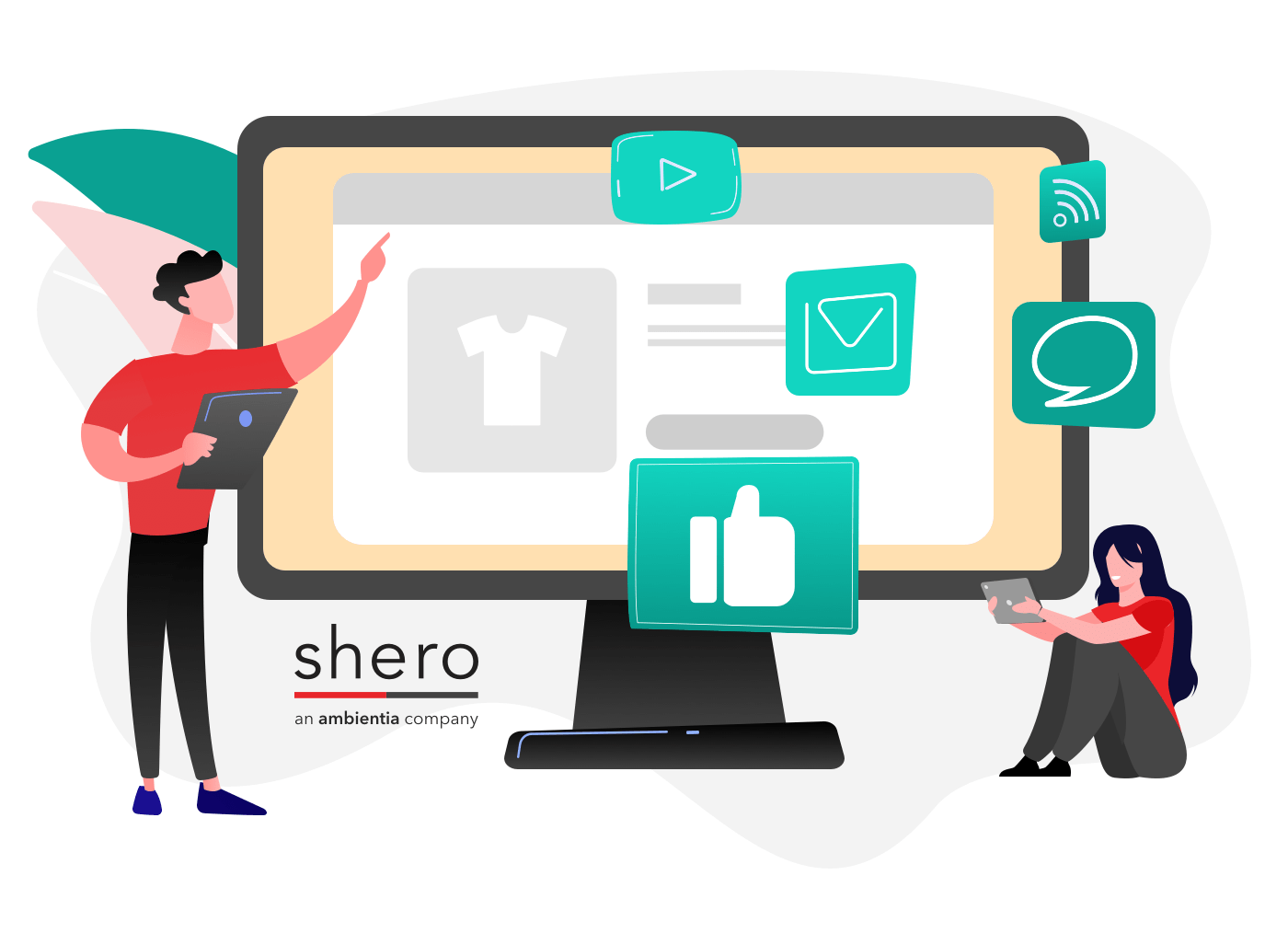If you regularly read our blog, you know we place a lot of importance on hiring the right people at the right time. It’s a simple yet not-always-obvious truth: Your brand can’t grow unless your team does. Recently we stressed the importance of hiring an eCommerce Director to keep your business moving forward. We’ve also described two other key positions needed to round out your eCommerce team.
But now that you know what positions to fill, how can you actually fill them? That’s what this Building Your eCommerce Team series is all about. As a Team Builder, one of my main responsibilities is to coordinate our recruiting. We’ve just wrapped up a big hiring season. Since January, we’ve welcomed three new people to the Shero team (shoutout to Caleigh, Brantley, and Carlos!), and hired a fourth to start later this year. We’ve worked hard to create a streamlined yet powerful hiring process, and now we’re passing our insights onto you.
Today I’ll lay the foundation by explaining three concepts that will shape your view of hiring: Framework, Mindset, and the Value of Preparation. In a later post, I’ll list the materials and tools you’ll need before you screen a single resume. I’ll also guide you through a simple step-by-step tutorial on slaying that intimidating dragon known as “Writing a job description.” Finally, we’ll dive into interviewing, making an offer, and the legal dos & don’ts to keep in mind.
Framework: The 3 Keys
This hiring approach pulls from Lex Sisney’s book How to Think About Hiring: Play Smarter to Win the Talent Game. These three keys—Skill & Fit, Value & Vision, and Compensation Demands—build the framework you’ll use to determine if a candidate fits your needs. The right candidate will be an excellent match in all three areas.
Because these ideas are so fundamental, I’m introducing them right off the bat. In a later blog post, I’ll outline how to assess these areas for each candidate.
Full disclosure: We didn’t model our hiring process after Sisney’s book; we only recently discovered his work through his website. But his framework articulates the strategy we’ve been using successfully for years, so I’ve adopted his terms.
Key 1: Skills & Fit
This includes technical skills and work style. “Technical skills” is self-explanatory; “work style” refers to how someone uses those skills.
Example of Work Style: Is this candidate a collaboration-focused Uniter or an assertive and independent Leader?
Creating a job description will help you identify and articulate what you’ll need in a new hire. I’ll walk you through an easy way to write a job description in the next blog post.
Key 2: Vision & Values
This describes a candidate’s inner motivations and values.
Example: At Shero we need people who (1) share our people-first vision, (2) prioritize healthy, long-term relationships, and (3) innately value our Guiding Principles like “Embrace Empathy” and “Work like a Farmer.”
This also includes traits that aren’t in a Mission Statement or values list, but are still needed to succeed in your team culture.
Example: Keeping skills sharp is essential in our field. We need people who are both eager to learn and internally motivated to do so. Traits like teachability, curiosity, and a hunger for growth are crucial for our team’s long-term success.
Making sure each team member shares our company’s Vision & Values is mission-critical for us, and it should be for you too. Remember, you can always teach someone how to use Magento or MailChimp. It’s much harder to teach someone how to value collaboration or how to take direction well.
If you hire people just because they can do a job, they’ll work for your money. But if you hire people who believe what you believe, they’ll work for you with blood and sweat and tears.― Simon Sinek
Key 3: Compensation Demands
A candidate’s Compensation Demands includes two compensation types:
• Tangible or hard compensation, like salary, bonuses, and benefits. The “dolla dolla bills, y’all.”
• Intangible or soft compensation. Soft comp is anything an employee values about working for your business.
Here’s an easy way to think of soft comp: Imagine a candidate is weighing two job offers with the exact same salary and benefits. What other factors will they consider when deciding which offer to accept? The answer will naturally vary from person to person, so uncovering each candidate’s definition of soft comp can take some investigation. We’ll talk more about how to do that in a later blog post.
Examples of Common Soft Comp:
• Flexible work hours
• A sense of purpose; meaningful personal fulfillment
• A no-office-politics culture
• The opportunity to “get in on the ground floor”
• The chance to learn new skills by wearing many different hats
Sisney recommends actually charting your candidates on what he calls the Draft Board. (See figure below; so-named because his system refers to a strategy used by some NFL teams). You won’t find a draft board on our office walls, but keeping it in mind may help you clarify where each candidate falls within the framework.
Lex Sisney’s New Hire Draft Board
“Market rate” is the average compensation for a company in your industry
& size range, with similar sales, growth prospects, and location.
An Intentional Mindset: Collaborative, not Competitive
Most companies treat hiring like a particularly grueling season of Survivor, minus those weird headband things. Under a traditional hiring approach, the candidate experience fosters a sense of cutthroat competition. Rather than the interviewer and interviewee working together to carefully assess fit, it becomes a win-or-lose question of making it to the next round. Interviewers act as distant judges, and candidates wind up guessing at the “right” answers to avoid getting voted off the island.
Ultimately, this approach is self-defeating and counterproductive. I can’t say it better than Lex Sisney:
The right candidate will be a supreme fit for this role, as well as your system and culture, and at a fair price [ie, at or below market rate]. Like a great marriage, if the relationship is going to work, then it will work for both sides. Both you and the candidate must feel like there’s alignment between what the candidate excels at and the needs of your organization, and that the exchange of value is fair to both sides. — Lex Sisney
Another simple, yet not-always-obvious truth: You can’t determine whether there’s a good two-way fit if only one half is doing the assessing. From the first contact with each applicant, make sure they know that you expect them interview you and your team as well. Then structure each interview with that in mind, giving the candidate plenty of opportunity to ask their own questions.
The Secret to Success: Be Prepared
It’s not only the second-best Disney song ever written; it’s the secret to a successful hire. Typically, companies hire when their team is already swamped with extra work. When everyone is pulling long hours, it’s tempting to snag a boilerplate job description, slap it on your letterhead, and call that good enough. But take a cue from Honest Abe:
Give me six hours to chop down a tree and I will spend the first four sharpening the axe. ― Abraham Lincoln
Hiring the right person demands an investment of time and money. It’s very easy to waste both by neglecting to plan. Taking the time to lay a solid groundwork will save you a world of headaches, and quite possibly an expensive “bad hire,” in the long run.
We hire at least a few times per year; by now, our interviewing process is a well-oiled machine. Proper planning is the oil that keeps the machine running. When done right, you won’t notice it. But when it’s insufficient, you can quickly find yourself burnt out, overheated, and broken down just when you need to be accelerating through the curve.
In other words, “good enough” just isn’t good enough.
Think about it: Do you want to attract a boilerplate, “good enough” employee, or someone who stands out in a crowd? Would you prefer to hire someone who only has a vague idea of what they want from their next position, or someone who has obviously invested time in pinning down exactly what they need, want, and have to offer?
When you’re the interviewer, it’s pretty easy to tell the difference between the two. What many employers don’t consider is that it works both ways: Candidates can just as easily tell when you’re truly prepared—and when you’re not.
Wondering what you need to prepare, exactly? Keep an eye on our blog! In our next hiring post, I’ll
• List what materials you’ll need to prep,
• Give you a toolkit that will put your hiring on the fast track, and
• Walk you through process of creating a job description that stands out in a crowd.
In the meantime, if you have any questions about hiring, or if you’re interested in seeing us cover a specific aspect, let us know in the comments.
And if the very idea of adding hiring to your To Do list sets your head spinning, don’t get overwhelmed—we can help! Partnership means doing whatever we can to see your business grow, and we’ve already helped several clients hire new people for their teams. Shoot us an email and we’ll start a conversation.
Adi serves as the Director of Solution Architecture at Shero, where his expertise in quality assurance and platform-specific knowledge greatly contributes to the successful launch of extensive eCommerce projects.
Known for his innovation and inquisitive nature, Adi is passionate about developing software and crafting eCommerce and digital strategies for our clients. In his role, he continually engages with the latest technologies, ensuring our clients and our team are poised for success.






